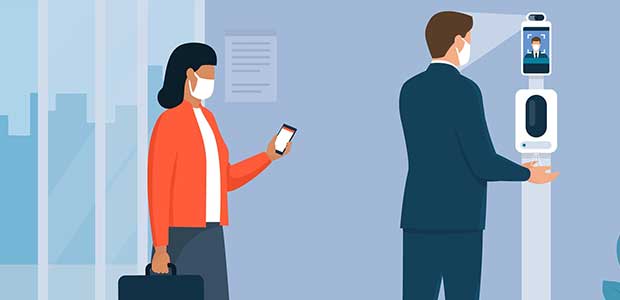
How to Responsibly Deploy Health Screening Technology
As with any workplace device, facial temperature screening technology must be deployed in the correct manner to have its desired effect.
- By Chad Rissanen
- Mar 22, 2021
In the drive to reopen workplaces, there has been a visible uptick in new workplace safety efforts. Chief among these are temperature screening and facial scanning units, whose market is expected to grow in the near future. But in the rush to get these devices up and running, business leaders should not do away with caution in the face of expediency.
As with any workplace device, facial temperature screening technology must be deployed in the correct manner to have its desired effect. This is especially the case with medical technology. The FDA’s official guidance is very clear on this point:
The available scientific literature supports using thermal imaging systems and non-contact infrared thermometers to detect elevated temperatures. These devices have many benefits, but they must be used properly to get accurate readings.
When deploying a new electronic device, execution is key. If managers truly want to limit the spread of COVID-19 and reopen safely, they must make sure that their thermal scanning devices are set up properly.
Here are a few ways that those deploying facial screening technology can get it right the first time:
Install the temperature screening device at ALL building entrance and exit points.
First and foremost, it is necessary to position the device so that it can detect the temperatures of everyone entering the building. Also, for the device to work, make sure that it is not obstructed by any objects that might impair its screening function.
Ensure compliance with national and regional safety guidelines.
In Canada, official reopening guidelines vary considerably between provinces. When reopening, it is important that business leaders make sure that deployed devices adhere to all official recommendations. The onus is on management to check and follow official hygiene stipulations.
Make the most of Cloud software and device apps.
Thanks to recent strides in cloud and mobile technology, it is possible for thermal screening data to be accessible on multiple locations, such as handheld devices. With dashboard summaries, providing information such as number of faces scanned, leaders can adjust their reopening plans to suit their workplaces.
Safeguard data privacy and rights.
Due to the negative associations with personal data capture inherent with health screening technology, facilities managers must ensure that the information collected by such devices does not infringe in any way on national data privacy laws.
Choose a health monitoring device that delivers consistently accurate results.
For counter-virus measures to work, employee temperatures must be screened regularly. In order for temperature checking to be more than a safety prop, managers should ensure that their screening technology can reliably measure body temperature. Tevano’s HealthShield, for instance, is accurate to ±0.9°F / ±0.5°C within 1 second, allowing it to process large groups of employees quickly and accurately. Without the ability to screen effectively for this COVID-19 symptom, office re-opening efforts will only be met with failure.
About the Author
Chad Rissanen is Chief Revenue Officer at Tevano, the developer of Health Shield™, an innovative, AI-driven, electronic device that provides instant body temperature scanning and notifies users if they need to wear a face mask.